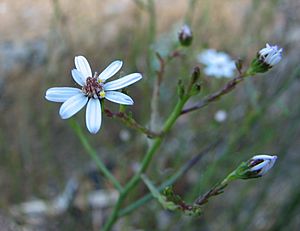Clustered daisy-bush facts for kids
Quick facts for kids Clustered daisy-bush |
|
|---|---|
 |
|
| Scientific classification | |
| Kingdom: | |
| (unranked): | |
| (unranked): | |
| (unranked): | |
| Order: | |
| Family: | |
| Tribe: |
Astereae
|
| Genus: |
Olearia
|
| Species: |
O. suffruticosa
|
| Binomial name | |
| Olearia suffruticosa D.A.Cooke
|
|
The Clustered Daisy-Bush (Olearia suffruticosa) is a special type of flowering plant. It belongs to the Asteraceae family, which is also known as the daisy family. This plant is a small shrub, usually growing up to 0.7 metres (about 2.3 feet) tall.
It has thin, straight leaves that are spread out along its stems. Its flowers look like small daisies. They have white or pink petals, called ray florets. Each flower head can have between 14 and 20 ray florets. In the middle, there are 18 to 28 tiny disc florets. These flowers usually bloom from January to April in Australia.
About the Clustered Daisy-Bush
The Clustered Daisy-Bush was officially named in 1985 by a scientist named D.A. Cooke. This plant is native to Australia. It is an important part of the natural environment there.
Where Does It Grow?
You can find the Clustered Daisy-Bush in certain parts of Australia. It grows in heathland areas, especially where the ground is a bit swampy. These areas are often wet and boggy.
It is found in three Australian states:
In Victoria, this plant is quite rare. It only grows in a few specific places. These include areas near Casterton, Glenisla, and Dergholm.
Why Is It Special?
Because it is rare in Victoria, the Clustered Daisy-Bush is listed as "vulnerable." This means it needs protection to make sure it doesn't disappear. The Department of Sustainability and Environment in Victoria keeps a list of rare or threatened plants. This helps people know which plants need extra care to survive.

